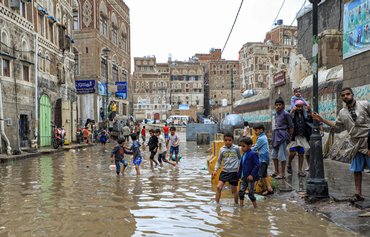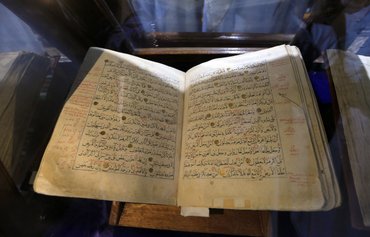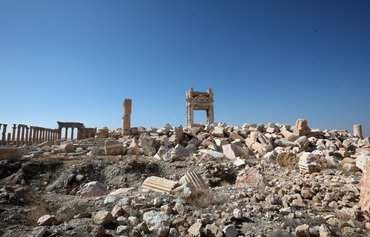The Houthis (Ansarallah) have been defacing the buildings of Old Sanaa, which are included on the UNESCO World Heritage List, by painting slogans on its historic walls and houses, local residents told Al-Mashareq.
Since the outbreak of the Yemen conflict, the Ministry of Culture has warned against the Iran-backed militia's deliberate and systematic defacement of the city's historical landmarks and monuments.
"The original and rare cultural heritage of Yemen has a great artistic and historical value, and has a human and cultural importance for Yemen and for humanity," the ministry said in a March 28th statement.
"Many of the rare historical landmarks and monuments are now facing direct and recurrent attacks," the ministry said, noting that Old Sanaa appears on UNECSO's World Heritage List and must be protected.
The Houthis have written sectarian slogans on the walls and houses of Old Sanaa "using dyes and colours made of harmful chemicals that damage the original colours of the houses and walls", the ministry said.
This disregard for the artistic and aesthetic features of Old Sanaa and for its history is similar to that of extremist groups that have destroyed historical and artistic landmarks in Iraq and Afghanistan, the ministry said.
The ministry has urged UNESCO to do all it can to safeguard and protect the heritage of Old Sanaa, and Yemen's cultural and artistic heritage in general.
'A disaster for Sanaa'
Deputy Minister of Culture Zayed Jabir condemned the Houthis' deliberate defacement of historic landmarks in Old Sanaa and in other old cities.
"The Houthis' tampering with the original colours of houses and walls in Old Sanaa and defacing them with their sectarian slogans, is aimed at obliterating the aesthetic features of Old Sanaa," he told Al-Mashareq.
"What is happening is a disaster for Sanaa," he said.
It shows the militia has no interest in the city's history, lawyer and activist Abdul Rahman Barman told Al-Mashareq.
"Their affiliations are with external entities and their loyalty is to Iran," he said. "Iran has a grudge against Arab and Yemeni civilisation, and therefore, it deliberately seeks, through its cohorts, to distort our civilisation," he said.
"Houthis are using historic castles as barracks," he said. "They also are using historic mosques as rest houses and military barracks, in an attempt to destroy the historic infrastructure."
Areas such as al-Jawf in Yemen's north have been used to store weapons or as bases from which to launch military operations, he added, which makes them the target of Arab coalition warplanes.
Yemen has a rich history, Barman said, noting that it was using the shura [consultation] system for administration long before it was known around the world.
"That group is trying to destroy that history and replace it with chaos," he said, referring to the Houthis.
Painting the city green
Media and rights activist Moussa al-Namrani told Al-Mashareq the Houthis are dealing with Sanaa as if it was conquered by sword.
"By changing the nature of the city and the prevailing colours in it, they aim to create a new domesticated generation who grows up to a city covered with green, as if this has been the identity of the city for hundreds of years," he said.
"On the other hand, they are trying to break people's morale and make them accustomed to seeing the sectarian green colour," he said.
The use of the colour green around the city is intended to display the Houthis' dominance, he explained.
"Citizens who will have their heads covered by green throughout the year, with green platforms under their feet, and green mosque gates and minarets everywhere, and with sectarian slogans on street corners, will have limited psychological options," he said.

![Two Yemeni men sit and talk by the ledge of a bridge as another woman and two girls pass by next to them, with the UNESCO-listed buildings of the Old City of Sanaa in background, on February 15th, 2017. [Mohammed Huwais/AFP]](/cnmi_am/images/2018/05/16/12606-Yemen-Sanaa-heritage-600_384.jpg)







No
Reply1 Comment(s)